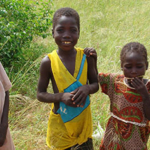


Helen Keller International, Inc.
IER, ICRISAT Mali, ULPC & AOPP
Mali
11/2010—11/2014
An Be Jigi in the Bambara language spoken in Mali means “Hope for all”. The project is in its second phase and is implemented two agro-ecological zones (Mande and Dioila districts) of Mali by Helen Keller International, ICRISAT and the food technology lab (LAT) of IER. The project seeks to address iron and zinc deficiencies in sorghum and pearl millet based diets by developing varieties of pearl millet and sorghum that are bio-fortified with iron (Fe) and zinc (Zn), promoting the use of health services and changing nutritional and feeding practices.The research conducted by the project during its first phase (2007-2010) indicated that intake of iron among children 7-24 months is only 3.4 mg/day against a recommended daily allowance (RDA) of 7 to 11 mg. For pregnant women intake was at 13.7 mg/day against an RDA of 27 mg. Food consumption surveys conducted during that phase also confirmed the importance of cereals in the Malian diets providing 69% of the total energy intake of children and 75% of the total energy intake of mothers. Cereals also provide around 50% of total iron intake, and about 75% of total zinc intake, resulting in iron intake that is far below international recommendations.During the current second phase, the project is undertaking additional research to investigate how to further improve the nutritional status of women and children, with an emphasis on the intake and bio-availability of Fe and Zn.
To improve sorghum and pearl millet varieties and cultivation practicesTo develop grain processing and food preparation methods/recipes for enhanced micronutrient nutritionTo determine the acceptability of those methods/recipes and quantify their nutritional valueTo enable behavior change for enhanced micronutrient nutrition through improved understanding and optimized intake and effective communication methods.
Variety trials showed that grain yields were doubled with the improved agronomic practice (application of DAP + Urea with high plant density) compared to that of the farmers’ habitual agronomic practice, especially for the local varietiesApplication of ash with high plant density resulted in a 30% increase in grain yieldsWhole grain processing of three sorghum varieties showed no differences for odor and texture and only ‘Doua G’ and ‘Tieble’ differed for taste (p= 0.03) of porridgePorridge prepared with 72-hour fermented flour (longest duration of fermentation) was the most preferred (3.9 of 5 (se =0.3) and fermentation for 24 hours was the least preferred with (2.7 (se= 0.3))The whole grain (non-decorticated) flours of the sorghum varieties Doua-G and Tieblé had the highest iron and zinc contents: 5.693 mg and 5.203 mg, respectively. The decorticated (refined) grains of both sorghum varieties had lower iron contents (3.51 and 3.37mg). Steeping of grain in acidic solution (pH 3.5) did not show significant improvement in Fer/Zn content. However, the acidic pH of steeping water may reduce phytate content and improve iron availability in whole grain flourMalted Doua-G and Tiéblé sorghum flours had iron contents which varied from 5.72 to 5.00 mg. Iron and Zinc content were higher than those of the control (3.5 and 3.37 mg for iron. Malting improved both iron and zinc content of the two sorghum varietiesDecorticated flour made from the Doua-G sorghum variety mixed with soybean, moringa leaves or okra seeds powder had improved iron and zinc content. The iron content of this composite flour varied from 15.75 gm to 4 gm, and zinc content varied from 3.04 to 1.58 gm/100 g. The composite flour containing soybean flour and 20 % okra seed powder had the highest iron and zinc content.The number of households which make daily use of whole grains in their cooking increased from 7 in a baseline study, to 96.Behavior change toward better nutrition and food practices and toward a health care seeking behavior has occurred in pilot areas but is a long term process. Focus group discussions revealed that women had begun to apply what they had learned and they were aware of the advantages. This will be better quantified with a “Knowledge, Attitudes and Practices” survey.Two recipes with whole grains developed: for production of whole-grain tô and gruel (dèguè). The following challenges were identified regarding the use of whole grain recipes: The processing of whole grain (procuring flour) requires pounding that is physically very demanding on women and it takes a long time to process. The use of whole grain in a family’s diet is a sign of extreme poverty in rural areas, which creates a significant cultural deterrent. Additionally, through informal discussions with older women in the community, it was learned that whole grain couscous (semolina made with sorghum or millet) “tastes better” than decorticated grain and requires less cooking oil compared to decorticated grain couscous.
